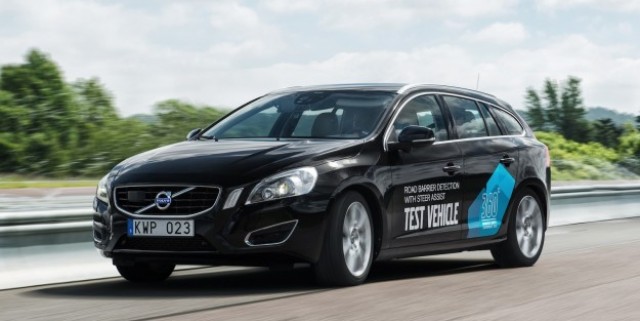
The all-new Volvo XC90 will feature three innovative new safety systems – including two claimed world firsts – when launches at the end of 2014.
All three utilise Volvo's latest camera and radar technology to pre-empt potentially dangerous traffic situations and help drivers avoid a collision if they fail to react to warnings.
The safety systems will initially be unique to Volvo’s new Scalable Product Architecture (SPA) platform, combining to offer a significantly reduced threat of death or injury to the driver and any passengers.
CarAdvice travelled to Volvo’s testing facilities in Gothenburg, Sweden, to test out the XC90’s headline safety acts:
Volvo claims the new XC90 will be the first vehicle in the world to offer a pedestrian detection and avoidance system that operates effectively at night. The system is an evolution of Volvo’s existing Pedestrian Detection technology, upgraded with a more sensitive camera with advanced exposure control.
Like most of Volvo’s pre-emptive safety systems, Pedestrian Detection relies on data gathered by both a camera and radar to inform the car’s decision making. Operating in darkness, Pedestrian Detection can autonomously brake to avoid a pedestrian at speeds up to 30km/h. Although this is 20km/h lower than its maximum operating speed in daylight, Volvo believes it will contribute significantly to reducing the road toll, quoting statistics from the Swedish Traffic Accident Data Acquisition (STRADA) that show 58 per cent of pedestrian fatalities occur at either dawn, dusk or at night.
Two test runs in a development vehicle saw the system perform flawlessly. After detecting a potential impact with a pedestrian (a dummy in our case), the system issues visual and audible warnings in the cabin as well as delivers an initial ‘brake impulse’ intended to get the driver’s attention. If the driver fails to react, the system applies full braking force to avoid the pedestrian, pulling up less than one metre before impact.
Volvo’s section manager for innovative safety electronics, Jonas Ekmark, believes road edge and barrier detection with steer assist has the potential to have the greatest impact on reducing the road toll of any of the manufacturer’s new technologies. In Sweden, 53 per cent of all traffic fatalities are caused by single-vehicle road departures, and the percentage is similar in the US.
The system uses the camera and radar to monitor the road edge and different kinds of roadside barriers. If the driver shows signs of unintentionally drifting too close to the road edge or a barrier, corrective steering is applied autonomously to return the vehicle back to the centre of the lane. The brakes are also applied if the system determines extra assistance is required to control the vehicle.
Volvo claims the camera’s ability to monitor where the physical road ends is another world first, and means it does not rely on lane markings on road edges. The car maker says the average speed of road departure incidents is 70km/h, though the system has bee programed to operate between 50km/h and approximately 200km/h.
Accelerating beyond 70km/h angled towards a concrete barrier on a wet section of track, the system had no trouble grabbing the brakes and steering our test car back into line away from danger in two runs. As with Pedestrian Detection, visual and audible warnings are emitted inside the car to encourage corrective reaction from the driver.
Adaptive Cruise Control with steer assist
Adaptive Cruise Control (ACC) with steer assist is one part of Volvo’s autonomous vehicle technology development. An evolution of the current ACC with Lane Keeping Aid, the new system again employs the camera and radar to monitor the vehicle directly in front, lock onto it, and take full control of the throttle, brake and steering. At any point, the system can be overridden by inputs from the driver.
Volvo says vehicles with ACC and collision warning are 42 per cent less likely to be involved in a motorway accident than regular cars, with inattention and distraction the leading causes of accidents in modern traffic.
The ACC with steer assist fitted to our test car required two steering wheel button actions: selecting ACC once the vehicle was moving behind a lead car and turning on the steering assistance component. Volvo says this layout will change before the launch of the new XC90. Designed for low-speed, stop-start traffic, ACC with steer assist allows drivers to take their feet off the pedals and hands off the wheel. Volvo is yet to confirm the upper speed limit of the system’s functionality, though it performed without fault up to 45km/h on CarAdvice’s test run.





